The Virus Hunter
Habitat loss, rapid population growth and global travel are creating a perfect storm for lethal viruses to spill over from animals to people. When and where will the next pandemic start?
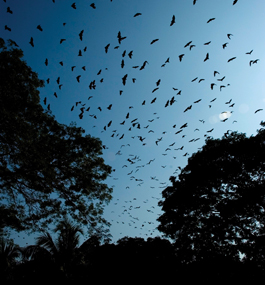
Jonathan Epstein
A bat colony swarms at dusk in Bangladesh.
by Carol Cruzan Morton
Here’s the scenario: Deforestation and intensive pig farming disturb the ecosystem of a group of Southeast Asian bats, causing a new virus to move from the bats to the pigs, then into the human population. One fatally infected woman traveling for business quickly morphs into hundreds of thousands of cases in many countries, creating a terrifying pandemic. Scientists rush to generate a vaccine that can stop the exotic pathogen.
This is more than the plot of the 2011 medical disaster film “Contagion.” It’s a cascading chain of all-too-possible events that veterinarian/epidemiologist Jonathan Epstein ’96 travels the world to predict and prevent.
The disease in “Contagion” is modeled on the lethal Nipah virus, one of the most threatening new infectious pathogens to jump from animals to humans. The Nipah virus first emerged in 1998, sweeping through pig farms in Malaysia and Singapore. Over a single extended one-year outbreak, 105 people directly exposed to the sick swine died — a 40 percent fatality rate. Three years later in Bangladesh, a more contagious and virulent strain of the virus was discovered spilling over from bats to humans, killing 75 to 100 percent of infected people.
Even more nerve-racking, many of the reported Nipah cases spread from person to person — an unsettling reminder of just how easily viruses carried by animals can adapt to human hosts — creating the potential for a pandemic. Since then, outbreaks have occurred almost every year in Bangladesh and twice just across the border in West Bengal, India, killing more than 200 people.
Epstein, associate vice president of conservation medicine at EcoHealth Alliance, an international conservation-science organization based in New York, flies to Asia regularly these days. The threat of deadly zoonoses, diseases transmitted from animals to humans, isn’t confined to medical thrillers. It’s real — and growing.
Right off the bat
A leading expert in Nipah virus ecology, Epstein focuses on the source of human contagion: uncannily cute but potentially deadly giant fruit bats — also called “megabats” or “flying foxes.” Their wingspan can stretch up to five and a half feet, nearly the height of the average Bangladeshi man. The huge bats are part of the Pteropodidae family, which includes Pteropus vampyrus, the large flying fox (a vegetarian, contrary to its popular image).
Scientists believe giant fruit bats are reservoirs for many novel and scary emerging diseases, including the Nipah virus. Though the bats appear unaffected by the pathogen, they spread it through their urine, saliva and feces to other animals and humans.
Through the lens of conservation medicine, bats add an unexpected twist to a “Contagion”-style plot. Agricultural expansion and global population growth are creating situations nearly guaranteed to transmit zoonotic pathogens. Yet hunting and habitat loss have pushed flying foxes onto the threatened-species list. Their eradication could be catastrophic, Epstein says.
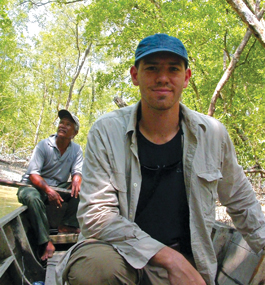
J. Westrum
BAT MAN: Epstein in a Malaysian mangrove swamp en route to a bat colony.
page 2 of 5
Flying foxes are vital to rain forest ecology. They’re agriculturally important pollinators, as essential to banana and mango crops as bees are to apples and avocados. So Epstein works both sides. He wants to help save people from bats and bats from people.
He has spent more than 15 years honing his bat-netting techniques on four continents, chasing the ecological origins of some of the world’s most fearsome emerging viruses. He and his colleagues want to learn why, after thousands of years of circulating like common colds among bats, more viruses seem to be spilling over into people.
Epstein remembers his first visit to Bangladesh, in 2006. To scout a suitably massive bat colony roosting in treetops, he recruited two local bat poachers named Pitu and Gofur (hunting bats is illegal in Bangladesh, but some Bangladeshis still eat bat meat).
Mission accomplished, Pitu and Gofur sat down to their lunches, watching with amusement as Epstein and a colleague set about extending volleyball-like nets on 20-foot aluminum poles to trap the fruit bats.
Because the bats were flying high above the lush treetops, the nets needed to be lashed to the upper branches. At a burly 220 pounds, Epstein doesn’t climb trees. So his teammate (a former tree surgeon with a background in ecology) assembled ropes and personal-safety equipment, then hoisted the nets and himself into the canopy, a proc-ess that takes more than an hour at its most efficient.
Pitu and Gofur laughed at the elaborate procedure. “These guys can run up a tree barefoot in 20 seconds,” Epstein says.
Into the wild
In Bangladesh today, Epstein has trained a local field team — including Pitu, Gofur and two veterinarians — in the latest bat surveillance protocols. The team traps bats; gently collects blood samples and throat, urinary and rectal swabs; does wing punch biopsies, for sophisticated molecular screening of pathogens and bat genetics; then releases the bats unharmed.
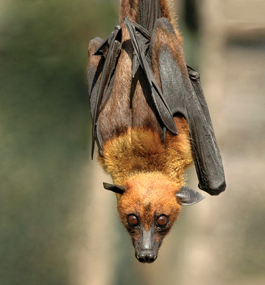
Jonathan Epstein
UPSIDE/DOWNSIDE: Flying foxes are vital to rain forest ecology; they are also reservoirs for many threatening new diseases, including the Nipah virus.
page 3 of 5
Wearing welder’s gauntlets over laboratory gloves, respirator masks and protective clothing, Epstein and his team adeptly untangle each bat from the net, with one person holding onto the back of the bat’s neck to restrain its head while another teammate extricates the wings and legs. They place the bat into a calming cotton pillowcase suspended on a branch or a rope strung between the trees. They further immobilize it with anesthesia delivered through a portable miniature respirator mask and tank. They have 15 minutes to collect samples and implant a microchip identifier. Then they feed the bat mango juice to restore its fluids and energy before gingerly releasing it.
“We need to test a lot of bats to find the one or two that are actually shedding the virus at any given time,” Epstein says. “Nipah virus infection is short-lived and relatively uncommon in these bats.”
Because the fruit- and nectar-eating flying mammals play a major role in pollinating plants and dispersing seeds, it’s important they be released back into the wild. Epstein and his team will not know if any of the bats they have handled carry the virus until lab analyses are completed weeks later.
No effort is made to destroy infected bats. “People always ask me, ‘Why not get rid of the bats?’” Epstein says. “This would be ecologically unsound. The real risk lies in human behavior, not the fact that bats carry a particular virus.” He says he and his colleagues look to reduce the chance of human infection by “understanding the risk factors for spillover into people, which tend to be human activities that manipulate the environment such that wildlife and livestock and people come into contact.”
So far, the small clusters of severe, often fatal pneumonia and brain inflammation caused by the Nipah virus — spread person to person through contact with respiratory droplets, feces or other secretions — have been limited mostly to family and caregivers, including health-care workers, in rural Bangladeshi and Indian communities. One cluster involved an infected spiritual leader who spread the virus by sharing a pipe during a religious ceremony.
Though these villages often are remote, Epstein and his team have sampled bats just three hours outside Dhaka, the capital of Bangladesh and the ninth-largest city in the world. An incurable virus could run rampant among Dhaka’s 12 million inhabitants — then hop by airplane in an infected person to another place on the planet in less than 24 hours, potentially sparking a rare but fearsome global pandemic. This year, a handful of Nipah cases reached Dhaka for the first time, Epstein says.
Although wildlife study has traditionally lagged years behind intense efforts to contain and shut down a human outbreak, the Bangladeshi government now incorporates Epstein’s local bat team into its seasonal outbreak investigations. Learning more about zoonotic pathogens in their natural hosts will help scientists predict and prevent the next pandemic, contend Epstein and his colleagues at EcoHealth Alliance, which is dedicated to the twin goals of protecting public health and safeguarding ecosystems.
Most, if not all, human infectious diseases arise from pathogens humans share with wild or domestic animals. The domestication of livestock, which started about 10,000 years ago, eventually led to the emergence of measles. In the modern era, zoonotic pandemics or near-pandemics have included HIV/AIDS, severe acute respiratory syndrome (SARS) and triple-reassortant A H1N1 influenza.
“We’re seeing more emerging diseases developing faster than at any time in our history,” says Epstein, referring to the estimated 400 new diseases identified since 1940, more than 60 percent of them zoonotic. “The question is why.”
Close encounters of the viral kind
Epstein has begun training local teams in other countries as part of a five-year international wildlife surveillance effort called PREDICT, funded by the U.S. Agency for International Development. The idea is to collect and identify known zoonotic pathogens and their relatives being carried by bats and other wildlife as a potential early-warning system for emerging diseases.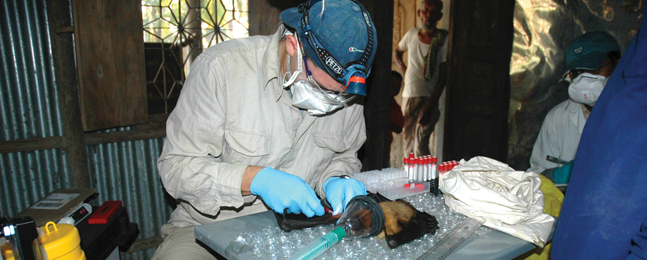
C. Smith
REST EASY: Epstein takes a blood sample from an anesthetized Indian flying fox. Hundreds of bats are tested to find the handful shedding virus.
page 4 of 5
Blocking a pandemic is not straightforward work. PREDICT focuses on infectious-disease hot spots spanning 20 developing countries. It looks especially carefully at activities that bring humans and animals into close contact, where cross-species transmission is most likely to occur.
“It’s totally unprecedented,” Epstein says. “It turns standard surveillance on its head. The traditional public health model is to wait for an outbreak to occur and then respond. This is ‘let’s find out what’s out there before it emerges.’ It might decrease the amount of time between the recognition of an outbreak and the discovery of its source.”
Over the first two years of the program, nearly 100,000 samples from 20,000 bats, rodents and nonhuman primates have yielded 150 novel viruses related to known zoonotic diseases. Sophisticated computer modeling is crunching field and lab data from animals and microbes to predict how human activities might influence outbreak risks and suggest possible solutions.
Last year, for example, Epstein and his colleagues uncovered the near-perfect conditions for a Nipah epidemic at the original outbreak site in Malaysia. A 30,000-pig factory farm was bordered by a mango orchard, attracting fruit bats, including Pteropus vampyrus, which can eat half their body weight in fruit daily. Half-eaten mangoes and bat droppings littered the pigs’ feeding troughs. The key to the outbreak: multiple spillover events from bats, coupled with the large size of the farm.
After the first spillover from bats, the infection should have run its course in about 60 days, leaving the exposed pigs immune to future infections, Epstein says. But the factory farming method created a smoldering viral burn by continually introducing immunologically naive piglets (which had been sequestered in a separate nursery area) into the general pig population, while bats continued to shed virus into the pens.
In Bangladesh, infectious-disease experts tracked the virus to Nipah-laden bat saliva, urine and feces found in raw date palm sap, a popular beverage harvested from trees like maple syrup, and sold fresh door to door within hours of being collected. A simple solution was devised to lower the infection risk: a bamboo screen placed over the buckets that catch the dripping date palm sap.
Epidemiologists worry about other viruses as well. In January, the EcoHealth Alliance team reported finding residual Ebola virus antibodies in five of 276 bats they tested in Bangladesh, suggesting the flying mammals might be a reservoir for Ebola, too.
Looking for answers in the dark
Epstein grew up west of Boston, the son of a software engineer father and psychiatric nurse mother. He remembers always being interested in conservation and wildlife. As a Brandeis undergraduate, in a sea of pre-med biology majors, he was the only one he knew headed to a career in veterinary medicine.
A pivotal experience in northeast Australia sparked Epstein’s interest in exotic wildlife. He studied abroad the summer of his senior year and worked in a Queensland rain forest sanctuary. Specialized classes in comparative anatomy, zoology, and venomous and poisonous animals fascinated him, as did the highly social squawking fruit bats that roosted outside his dormitory at St. John’s College, University of Queensland. He was hooked.
After entering veterinary school at Tufts University, Epstein signed up for an experimental new master’s program in public health. Eager to return to Australia to do research as a DVM/MPH student, he cold-called one researcher after another, saying he had received grant money to study a recent outbreak of rabies there that had killed two people after they handled bats.
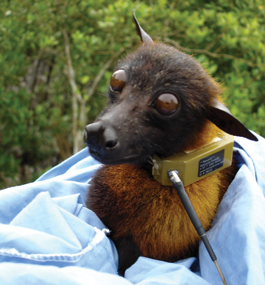
Jonathan Epstein
KEEPING TRACK: A flying fox outfitted with a satellite collar.
page 5 of 5
Most of the researchers hung up, he recalls. One said yes: wildlife veterinarian Hume Field, who had just identified flying foxes as the source of the rare but worrying Hendra virus (a sister virus to Nipah), which gains a fatal foothold in horses and jumps to people who come in close contact with severely affected animals.
“I thought it was cool I had the opportunity to study zoonotic diseases in bats, but I never thought I would make it my career,” Epstein says.
His third year at Tufts, Epstein invited EcoHealth Alliance president Peter Daszak to campus for a student-organized conference on emerging diseases. Daszak had written an influential treatise on conservation medicine in the weekly journal Science, where he coined the term “pathogen pollution” to describe how human activities inadvertently drive the emergence of infectious diseases that spill over from their wildlife hosts to farm animals and people.Conditions have never been more favorable for an emerging zoonotic pathogen to thrive, Daszak wrote. The human population is expanding. Cities are becoming more densely populated. People and livestock are encroaching on wildlife habitats. Wildlife from environmentally degraded areas are moving into urban and suburban regions. The global transport of people, animals and animal products is becoming ever faster.
In search of an experienced bat handler/epidemiologist, Daszak hired Epstein to study Nipah in Malaysia in 2001. Epstein’s knowledge also led him into China’s heartland to help track the source of the SARS coronavirus, which first infected a human in 2002 and soon sickened 8,096 people, killing 774, with major outbreaks in Hong Kong and Toronto. Although civets were originally suspected as the host, Epstein and his colleagues eventually pinpointed the real source — bats butchered and sold fresh in an open-air market — an insight later published in a 2005 Science paper.
Bats, in many ways, epitomize the issues underlying emerging zoonotic diseases, Epstein says. With 1,200 species, bats represent 20 percent of the diversity of Earth’s mammals. Only rodents, at 40 percent, are more diverse. Both bats and rodents live close to people, often in large numbers. Human activities create new opportunities for virus spillover and spread: agricultural expansion into pristine forests (Nipah in Malaysia), wildlife trade (SARS in China) and global travel.
Epstein’s job as an epidemiologist begins where the public health team’s ends. “Their primary job is figuring out what is making people sick, how people are getting sick and stopping further transmission,” he says. “We ask different questions: Why did this outbreak happen in the first place? Where did it come from? What would make it happen again? We conduct more in-depth ecological studies of the system.”
Knowing how to minimize the reach of an infection is key. “The more we as a scientific community learn about risk, the more we can work to change the way we do things and decrease the risk of an infectious disease getting out of hand,” Epstein says. (Even affluent America needs to work on reducing risk. One of Epstein’s pet peeves is the propensity of sick Americans to go to work, where they spread their infections, rather than stay home.)
The accumulating scientific knowledge is starting to pay off. Last October, one of Epstein’s colleagues at Columbia University received a call from the Saudi Arabian health minister: A small outbreak of a severe disease had infected two people. The pathogen, a novel coronavirus, was first identified in a Saudi national being treated in London for a severe respiratory infection. He eventually died. Samples of the virus genome showed it was related to an endogenous bat coronavirus, similar to SARS, but of a type not previously known to infect people.
Three days later, Epstein and the colleague were on a plane, and soon thereafter he was tracking down bat colonies roosting in the cool, dark interiors of crumbling ruins in the Saudi desert. As of early March, the virus had racked up eight fatalities in 14 cases in Saudi Arabia, Jordan and Qatar.
The source of the infection remains a mystery — but with any luck, now that Epstein and his team are on the hunt, that won’t be true for long.
Carol Cruzan Morton is a freelance science writer in Boston.
